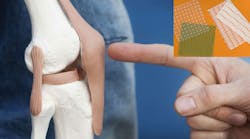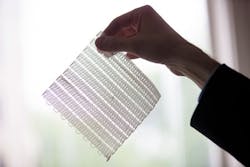MIT engineers have designed pliable, 3D-printed meshes that can be adjusted in terms of flexibility and toughness so they can emulate and support soft tissues such as muscles and tendons. The intricate structures in each mesh can be fine-tuned by the person doing the printing. This could lead to tough-yet-stretchy material being used as personalized, wearable supports (including ankle or knee braces) and even implantable devices (such as hernia meshes) that better match the patient’s body.
As a demonstration, the team printed a flexible mesh for use in an ankle brace. They tailored the mesh’s structure to prevent the ankle from turning inward — a common cause of injury — while letting the ankle move freely in other directions. Researchers also made a knee brace design that conforms to the knee even as it bends. Another potentially useful medical device they developed is a glove with a 3D-printed mesh sewn on top which conforms to the wearer’s knuckles. This could provide resistance against involuntarily clenching the hand, an involuntary motion that can occur after a stroke.
“This work is new in that it focuses on the mechanical properties and geometries required to support soft tissues,” says Sebastian Pattinson, who conducted the research as a postdoc at MIT.
The team’s flexible meshes were inspired by the pliable, conformable nature of fabrics. “3D-printed clothing and devices tend to be bulky,” Pattinson says. “We were trying to make 3D-printed constructs more flexible and comfortable, like textiles and fabrics.”
Pattinson found further inspiration in collagen, the structural protein that makes up much of the body’s soft tissues and is found in ligaments, tendons, and muscles. Under a microscope, collagen can resemble curvy, intertwined strands, similar to loosely braided elastic ribbons. When pulled apart collagen initially stretches easily as the kinks in its structure straighten out. But once taut, the strands become harder to pull apart.
3D meshes are designed to be lightweight and conformable, similar to fabric and textiles. (Courtesy: Felice Frankel)
Inspired by collagen’s molecular structure, Pattinson designed wavy patterns, which he 3D printed out of thermoplastic polyurethane. He then devised a mesh that resembles stretchy yet tough, pliable fabric. The taller he designed the waves, the more the mesh would stretch at low strain before stiffening—a design principle that can adjust a mesh’s flexibility and lets it mimic soft tissue.
The researchers printed a long strip of the mesh and tested its support on the ankles of several healthy volunteers. For each volunteer, the team stuck a strip along the length of the outside of the ankle, oriented to support the ankle if it turned inward. They then put each volunteer’s ankle into an ankle stiffness measurement robot named, logically, Anklebot. The robot moved their ankles in 12 different directions and measured the force the ankle exerted with each movement, both with and without the mesh. This helped the researchers understand how the mesh affected the ankle’s stiffness in different directions.
In general, they found the mesh increased the ankle’s stiffness during inversion, while leaving it relatively unaffected as it moved in other directions.
The beauty of this technique lies in its simplicity and versatility. Mesh can be made on a basic desktop 3D printer, and the mechanics can be tailored to precisely match those of soft tissue, according to the researchers.
The team’s ankle brace was made using relatively stretchy material. But for other applications, such as implantable hernia meshes, including a stiffer material that is just as conformable could be useful. To this end, the team developed a way to incorporate stronger and stiffer fibers and threads into a pliable mesh. It prints stainless steel fibers over regions of an elastic mesh where stiffer properties would be needed, then printing another elastic layer over the steel to sandwich the stiffer thread into the mesh.
The combination of stiff and elastic materials gives meshes the ability to stretch easily up to a point, after which it starts to stiffen. This provides stronger support to prevent, for instance, a muscle from overstraining.
MIT engineers 3D-printed stretchy meshes with customized patterns designed to be flexible, yet strong for use in ankle and knee braces. (Courtesy: Felice Frankel)
The team also developed two other ways to give their printed meshes an almost fabric-like quality, letting it conform easily to the body, even when the patient is moving.
“One of the reasons textiles are so flexible is that the fibers move relative to each other easily,” Pattinson says. “We wanted to mimic that in the 3D-printed parts.”
In traditional 3D printing, a material is printed through a heated nozzle, layer by layer. When heated polymer is extruded, it bonds with the layer underneath it. Pattinson found that once he printed a first layer, he could slightly raise the print nozzle and material coming out of the nozzle would take a bit longer to land on the layer below, giving it time to cool. As a result, it would be less sticky. By printing a mesh pattern in this way, Pattinson could create layers that could move relative to each other rather than being fully bonded.
Finally, the team designed meshes that incorporated auxetic structures—patterns that become wider when you pull on them. For instance, they print meshes with the middle made up of structures that became wider when stretched rather than contracting as a normal mesh would. This could be useful for supporting highly curved surfaces of the body. To that end, the researchers fashioned an auxetic mesh into a potential knee brace design and found that it conformed to the joint.
“There’s potential to make all sorts of devices that interface with the human body,” Pattinson says. "”Surgical meshes, orthoses, even cardiovascular devices like stents.”



